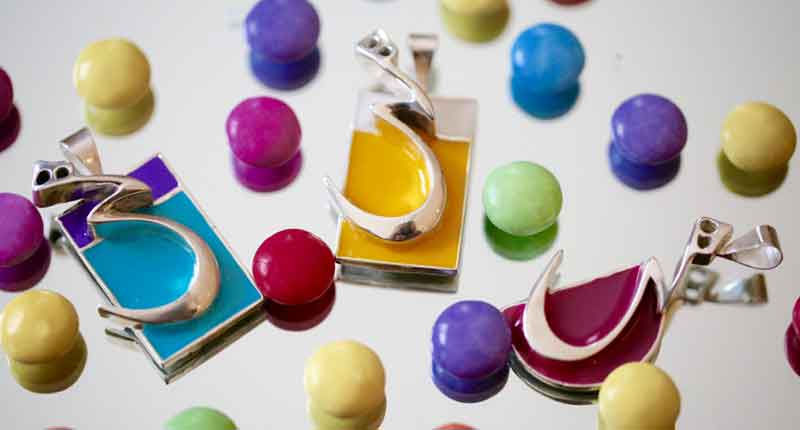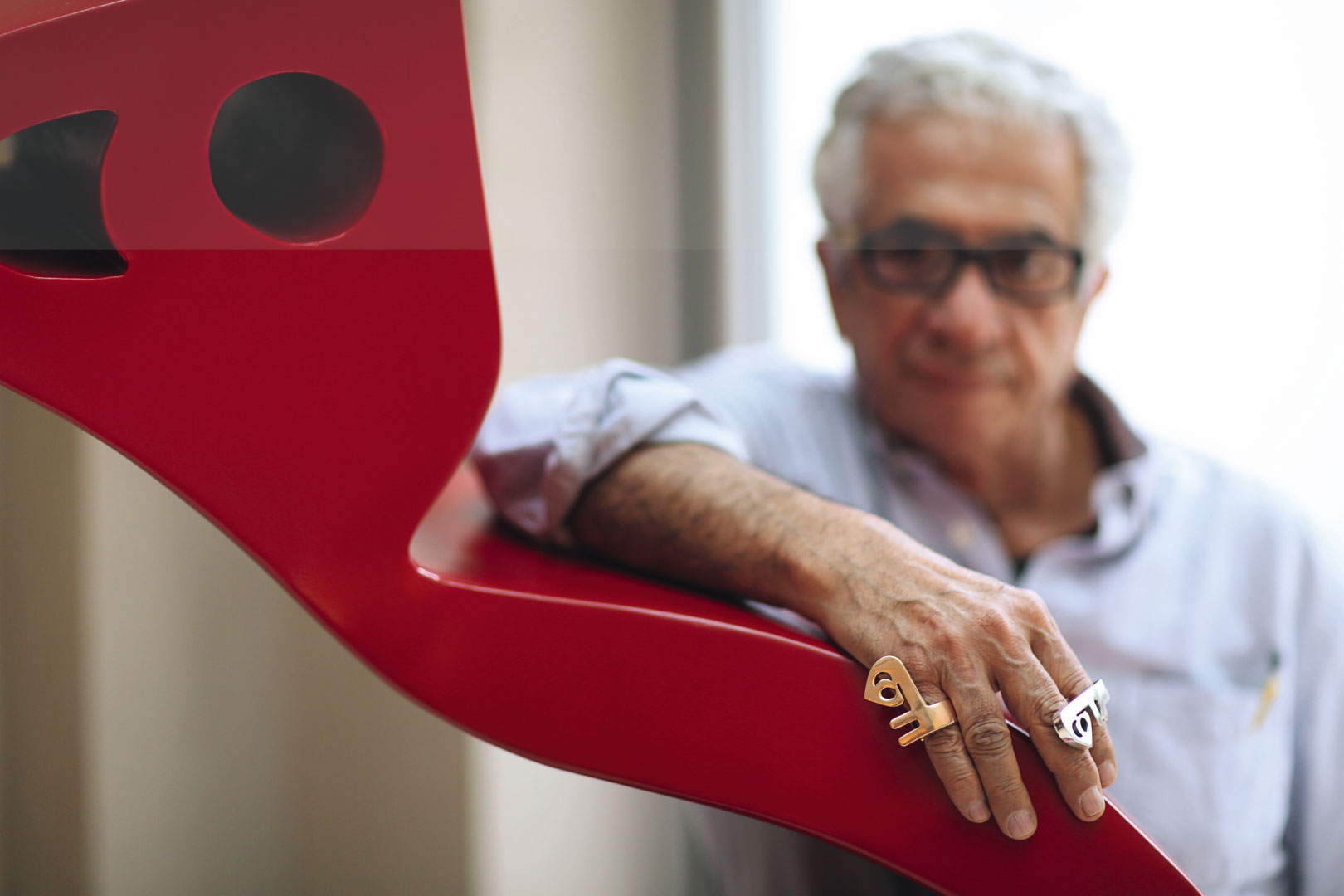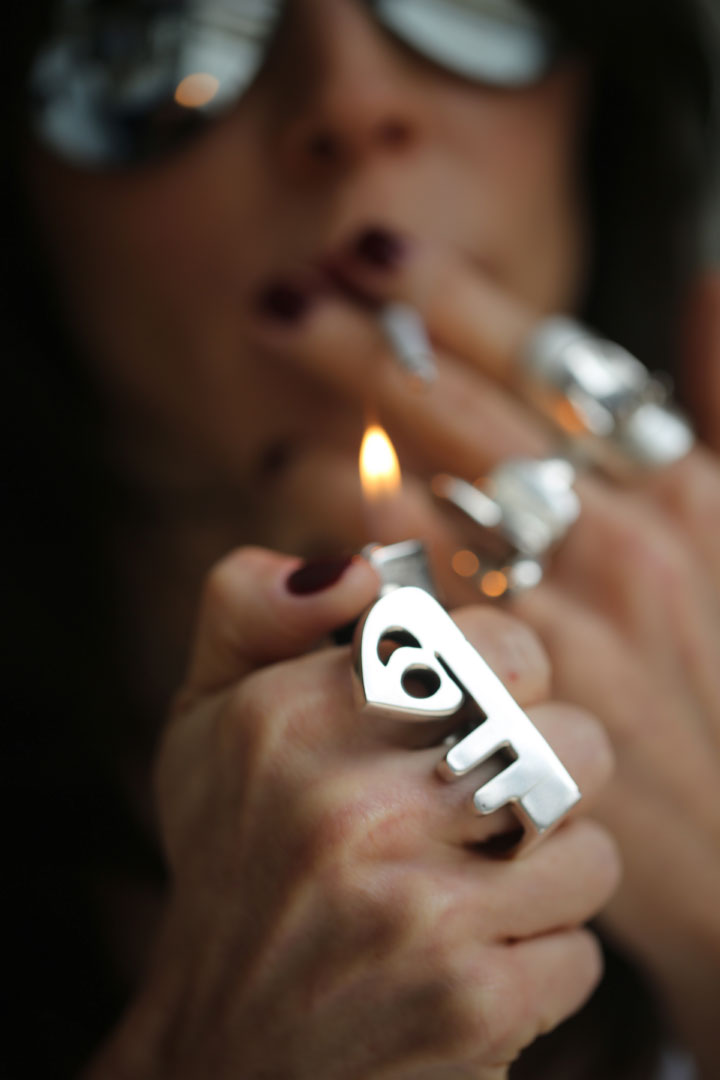"Sweet Nothings: Parviz Tanavoli Talks Jewellery"
By Maryam Eisler | Harper's Bazaar Arabia
15 March 2016

Renowned for his appropriation of Persian folkloric references, artist Parviz Tanavoli has incorporated his iconic symbolism into jewellery pieces. Maryam Eisler meets the artist in London to speak about his jewellery
Maryam Eisler: When did you transition into jewellery? And, in doing so, did you see it as an extension of your artistic oeuvre?
Parviz Tanavoli: I started a long time ago. I was making large Heeches in the mid-60s, and I wanted to make smaller Heeches, too. I began by making Heech rings, bracelets, and cuff links. When I had time in between my sculpture practice, I made some little things, and from the mid-80s up to the 90s, the jewellery line became a real collection, with a proper following. However, I really never looked at it as jewellery, but rather as my little sculptures.

ME: Do you think these smaller objects resonate more deeply with the masses? Do they offer a wider reach and more visibility?
PT: All of what you say is very true. I must admit that the demand for my jewellery has always been immense, and I have never really been able to satisfy or fulfill the quantities that I was asked for, especially as I have always produced my work in editions. I also believe that jewellery is more desirable than sculpture. A great number of those who wear my jewellery feel like they own a small sculpture by me; as such, my jewellery is viewed as an art form. They also view it as something flexible and mobile, something they can use and move around with, as opposed to a permanent and stationary sculptural installation. I was always very happy producing these smaller objects and seeing them worn and enjoyed by different people.
ME: Does your jewellery offer the world an extension of your philosophy? Do you consider it to be a tool for propaganda?
PT: Well, you can put it that way, I suppose, because people wear them and they are seen everywhere. A piece of one’s jewellery, when worn at a party or at a gathering, always becomes a topic of conversation. You cannot do that with heavy sculptures. You cannot take them around with you. So I never thought about it that way, but you have a point, in that jewellery can be like propaganda for an artist! You’re extending your voice and your reach into the masses.
ME: You’ve travelled extensively throughout Iran and you’re a big connoisseur, researcher and promoter of Persian culture, tradition and folklore—both through your work and your publications. How much have your travels, your research as well as your personal collection of Persian artefacts (locks, amulets, carpets etc.…) informed your work in jewellery?
PT: I have a substantial collection of old jewellery, and whenever I get the chance, I like to acquire and add to my collection. But to tell you the truth, I have never followed rules in the production of my own jewellery. Jewellery, for the most part, tends to be decorative, but to me, my own work in this field is not decorative. My jewellery represents a minimisation of my sculptures, void of decorative elements such as beads, gems and stones. There is no question that my research and travels have inspired me, but they haven’t had a direct aesthetic impact on my jewellery design.
ME: I recently read about the important role of jewellery in Persian society, especially dating back to the Achaemenid and Sassanian dynasties. While there was incredible craftsmanship and detail in the making of this jewellery, these collections were entirely without provenance. We don’t really know who made them.
PT: The Achaemenid and the Sassanian periods, in particular, counted great craftsmen. I always get amazed by how knowledgeable they must have been and to what extent their studios must have been well equipped—for casting, embossing and engraving. Up until the 19th Century, Iranian jewellery was very strong, and its main characteristic was about being Persian. But then, of course, with the import of Western jewellery (in particular French), this quickly changed. When I began making jewellery, I always wished that we would go back somehow to our own Persian traditions and crafts. They were always unique, always recognisable — both in the Middle East and elsewhere. A decade or so ago, I began giving jewellery courses in Tehran, and now, you cannot believe how many young students are actually making jewellery and making a living out of it. Modern Iranian jewellery has now made up for the long historic time pause that we have experienced in this particular field.
ME: Women have featured heavily in your work. Of course, there are always your Lovers, but other examples include your continuous fascination with Farhad the Mountain Carver, who dies in the name of his beloved, the beautiful Shirin. Is the act of making jewellery for women possibly a symbolic act of your respect and admiration for them?
PT: Well yes, you are right: I do think of women very highly. In my life, women were instrumental in building my career, starting from my mother and my wife. Women are also looked at highly in Persian culture and history in general, especially throughout literature and poetry. Iranian women are very special women. I have always enjoyed making jewellery for them, and I love seeing them wear my sculptures. It is an honour for me to design for them.
ME: Could men wear your jewellery?
PT: Of course! My rings in particular are genderless. And yes, men can wear them. Some of my sculptures, as you know, also happen to be genderless — take, for example, Heech, which is neither man nor woman!
ME: I am very excited to see a new direction in your jewellery design today. Correct me if I am wrong, but I think that you’ve allowed yourself to be a little freer, more whimsical, and playful in your designs. You have somewhat moved away from the expected forms.
PT: I’m glad you say that. I feel that way, too! I definitely feel freer. I like to play. I want to get out of that rigid framework. I’ve been in it for years, with my themes like the Heech, like my Lovers, and so forth. Now, I feel I can fly again to new horizons, and I can dedicate myself to extending my work, through the application of new designs, new themes and colours. I feel colour, in particular, has been missing in my work, and I am excited to introduce this new parameter in my designs. In the past, I have seldom used colour—only sometimes through my favourite stone, the Turquoise, the symbol of Persia—but that’s about all. Today, the resin I am working with offers me new possibilities. I still produce the same kind of shapes, but I enjoy linking them with coloured resins. And, with this, I feel I am gaining greater satisfaction, more than ever before!
ME: Would you say you have developed new wings? And, if so, to what do you attribute this new creative freedom and fluidity?
PT: During this period of my life, I feel like a flower that is blooming once again. I have nothing to prove, and I like the idea of trying everything. I want to experiment. This didn’t happen to me before, but today, if an idea comes to my head, I don’t hesitate. I don’t stop myself. I plunge straight into it! Of course, making jewellery by definition should be about having fun with the process, because if you have an idea, you can bring it to fruition a lot faster than the larger scale sculptures. That in itself is liberating!
ME: Jeff Koons, Michael Craig-Martin, Anish Kapoor and many other renowned contemporary artists have, at some point in their career, extended their work into jewellery design. I don’t believe this holds true in Iran, except for you. Am I correct?
PT: In Iran, I don’t know of any other contemporary of mine who has embarked in jewellery making; I mean, for me, it happened very spontaneously. It was not a question of following the West nor was it about following other artists. It just happened. I wanted to create the smallest Heech in the world, in the shape of a ring, and I thought to myself ‘why not?’ Other Iranian artists haven’t tried, but the new generation, many of whom I have personally trained and taught, and all of whom have an art education background, are indeed very interested. I think there is going to be a great boom in the making of modern jewellery in Iran.
ME: Tell me about the possible talismanic functions of your jewellery.
PT: Funny you ask as I am, in fact, very much interested in talismans. I study them and I have written a book about them. Of course, in my opinion, jewellery that has a positive vibe and energy can also act as good omen. As such, it will be liked and warmly adopted by its owner, during the course of their relationship. Through my jewellery, I try to give a sense of optimism, of hope and of beauty.
 A Tanavoli ring
A Tanavoli ring
ME: There is great intimacy between a piece of jewellery and its wearer; there’s almost a love affair at times. You can become attached to a piece of jewellery that you possibly wear every day of your life. Do you think that, either consciously or sub-consciously, you may use your jewellery as a device to penetrate the soul, the psyche of its wearer?
PT: What you say is beautiful … I wish I had said it myself. So, I guess my answer to your question is a definite yes! There is no doubt that jewellery is always a silent observer of and a constant companion to its carrier.
ME: Can you recall a compliment that you have received for your jewellery and which has particularly touched you?
PT: More than a few times, young brides and grooms have asked me for a Heech ring or a Lock ring for their wedding ring. That is always very touching!
ME: Finally, what’s in store for the future of your jewellery designs?
PT: I don’t know what the future holds and that is the beauty of it! What I do know is that I look forward to finding out. At the end of the day, for me, it’s all about creating. That’s what keeps me going. That’s what keeps me alive.
Maryam Eisler is a trustee of the Whitechapel Gallery in London and of Wellesley College in Massachusetts , her Alma Mater. She co-chairs the Tate Middle East North Africa Acquisition Committee and is a member of Tate ‘s International Council. She is also a member of the Guggenheim Middle East Circle , the British Museum Middle East Acquisition Committee and sits on the advisory Council of the Delfina Foundation. She has held Executive Editorial roles for Sanctuary : Britain’s Artists and Their Studios, Art Studio America : Contemporary Artist Spaces and the latest title, London Burning : Portraits from a Creative City ( Thames and Hudson). She is currently working on a photography exhibition of her own works, destined to open in the Fall of 2016 (at the Tristan Hoare Gallery in London), entitled “Eve and the Light of the American West”.
Parviz Tanavoli’s jewellery can be found at the Louisa Guinness Gallery. Photography: Maryam Eisler. This article appears in the Spring 2016 issue of Harper’s Bazaar Art
